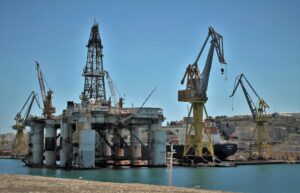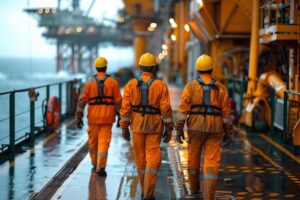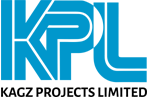6 Guides To Successful Offshore Construction
What is Offshore Construction all about?
Offshore construction project involves the construction or set-up of structures and facilities in a marine environment. This is usually for the purpose of transmitting resources such as oil and gas, electricity, or other resources. More so, these facilities do not only ensure proper transmission of resources, but also function in the production of these resources.
One may think, why go through the stress of getting on water just to get these resources. Can’t they be sourced some other way?
These resources are usually located beneath the sea bed. They are not easily assessable by onshore drilling. The existence of offshore ensures economic growth and enhanced energy security. Beyond the oil and gas sector, offshore construction projects are important to those in the logistics and technological industries, as well as those in the aquaculture and fishery industry.

You can see that this construction type is much different from the usual civil construction projects like the ones we’ve already discussed here https://kagzprojects.com.ng/the-construction-journey-a-tale-of-the-triumphs-and-trials-of-construction-and-mechanical-engineering/
How does this work?
Offshore construction encompasses some vital stages such as onshore design, construction, transportation, installation and maintenance stages.
As interesting as this field is, it comes with unique sets of challenges, especially because it is operated in a demanding marine environment. Every facility or structure is set up for the transmission of something, either a resource or a natural gas. Due to this, every facility is built to meet the specific needs of the resource it’ll be transmitting. For instance, a structure built for oil and gas extraction wont be same as one set up for electricity transmission.
But that’s just one of the many challenges involved. The marine environment places a lot of demands on offshore construction projects. Because this project is run on water, you can easily envision the challenges that will come up such as logistics, harsh weather or environmental conditions, high costs and safety concerns of personnel and work materials.

While offshore construction comes with a truck load of challenges, it’s exciting and relieving to know that these challenges aren’t insurmountable, Kagz Projects Limited has identified effective strategies to mitigate the risks of these challenges occurring during a project.
With these strategies in place, it’s certain that you can improve efficiency, save costs, reduce the risk of incidents, and ensure safer operations.
Now, let’s dive into the key strategies that help address the challenges in offshore construction.
STRATEGIES FOR A SUCCESSFUL OFFSHORE CONSTRUCTION
- Comprehensive Planning And Risk Management
Of course, you already know that if you fail to plan, you have already planned to fail. This applies in offshore construction. You must first sit down to make plans of all you want to do. This should include all personnel that will be contributive to the execution of the project.
Risk management helps you to look ahead for potential occurrences of risks. Offshore construction comes with unique challenges; therefore, you want to carefully implement a robust plan that mitigates risks. This can be achieved by
- Carrying our site surveys and feasibility studies. Carefully look at the seabed conditions, environmental factors and even logistics demands. For instance, geotechnical surveys are carried out to determine the stability of seabeds before installation of pre-commissioned constructions. This is to prevent the risk of foundation failures
- To avoid the risk of harsh weather delaying projects, it’s best to set up safety protocols, and enforce real-time environmental monitoring to help reduce incidences and also protect lives. It’s also advisable to employ predictive maintenance such as robotics and data analytics to predict equipment breakdown which is also classified as a huge risk while offshore. This helps with logistics and planning to avoid being stranded.
- Ensure the projects meet regulatory standards.
2. Efficient Logistics Planning and Supply Chain Management
Every successful offshore construction project is indicative of a successful supply chain management. Offshore construction project relies heavily on timely delivery of materials and equipment. This is crucial because offshore construction often takes place in remote places. A failed logistic plan results in incurring more costs than what was originally budgeted for. Imagine using a helicopter to fly in a screw to a remote location. Of course, that piece must be very important to the project and so must be flown in before the project continues.
To avoid and overcome these logistical challenges, you can adopt supply chain optimization techniques and use floating logistics bases to reduce the time and cost of transporting resources to remote locations.
3. Engage technology
Modern technology is the best ally for everyone in the construction industry because it enhances safety, boosts efficiency, and aids decision making. Offshore construction can produce faster, safer, and efficient results by utilizing technologies such as
- Remote monitoring systems; helps with real-time data collection that aids decision making
- Digital twin technology; this helps in monitoring assets to be used offshore to determine their efficiency and working status. This is usually done onshore to prevent the risk of incurring logistics cost during the offshore construction process.
- Predictive maintenance; uses data analytics to predict equipment functionality onshore before going offshore.
- Robotics and automation to streamline maintenance tasks
- Weather forecasting software for weather predictions and to avoid harsh weather creeping in on the team during a procedure. Nobody likes having downtime because it eats into productivity time. So, avoid the downtime by looking at what can possibly happen while you’re offshore.
- Advanced material coatings to protect against corrosion, radiation and other harsh environmental conditions.
- Virtual reality technology is employed to train personnel against incidents and accidents during project execution. These simulations allow offshore personnel gain experience of possible risks without exposing them to the risks. In addition to prioritizing safety, there must be strict adherence to the use of PPEs.
4. Efficient Pre-commissioning strategies
Every offshore construction should begin with the pre-commissioning stage. It is a series of tests carried out on newly constructed offshore facilities to ensure they are safe for use and functional. This helps save logistics costs; once a design isn’t functional, it is worked on before transportation to the site of use.
While pre-commissioning is important, maintenance strategies are also put in place to ensure that there are no sudden breakdowns during operations. Equipment maintenance can be facilitated by routine inspections and by the use of remote asset monitoring. If you’re planning an offshore project, you want to ensure that you cut costs at every means possible by optimizing construction processes and even logistics requirements.
5. Cost Optimization:
If you’re planning an offshore project, you want to ensure that you cut costs at every means possible by optimizing construction processes and even logistics requirements. Cost optimization allows you carry out efficient project planning and budgeting. It also helps reduce wastages and maximizes efficiency to yield productivity
6. Effective Communication:
Offshore projects involve multiple teams working across distances. The ability of each team to correctly understand what is expected of them is key in delivering high quality jobs. Some communication strategies for efficiency are;
- Utilizing satellite communication and high speed data networks for reliable connections between multiple teams
- Utilizing cloud-based project management tools for efficient document sharing and optimal collaboration between teams
- Standardized report structures for prompt dissemination of information and to prevent miscommunication and delays.
Lastly, it’s important you consider the locals in the area. Partnering with the locals helps you to be culturally sensitive so that you don’t go overboard during your operations to do something they’ll frown at and in turn oppose your mission. The locals provide you with regulations you should stick with to aid productivity and efficiency.
There’s also the challenge of language barrier and time zones differences. These can be tackled with patience, flexibility, and a proactive problem solving approach.
If Kagz Projects Limited can overcome these challenges to carry out offshore construction projects, rest-assured, you can too. However, you can reach out to us for more consultation if you ever need help. Remember, offshore construction is not just a walk in the park, it’s a hurdle that can be crossed.
